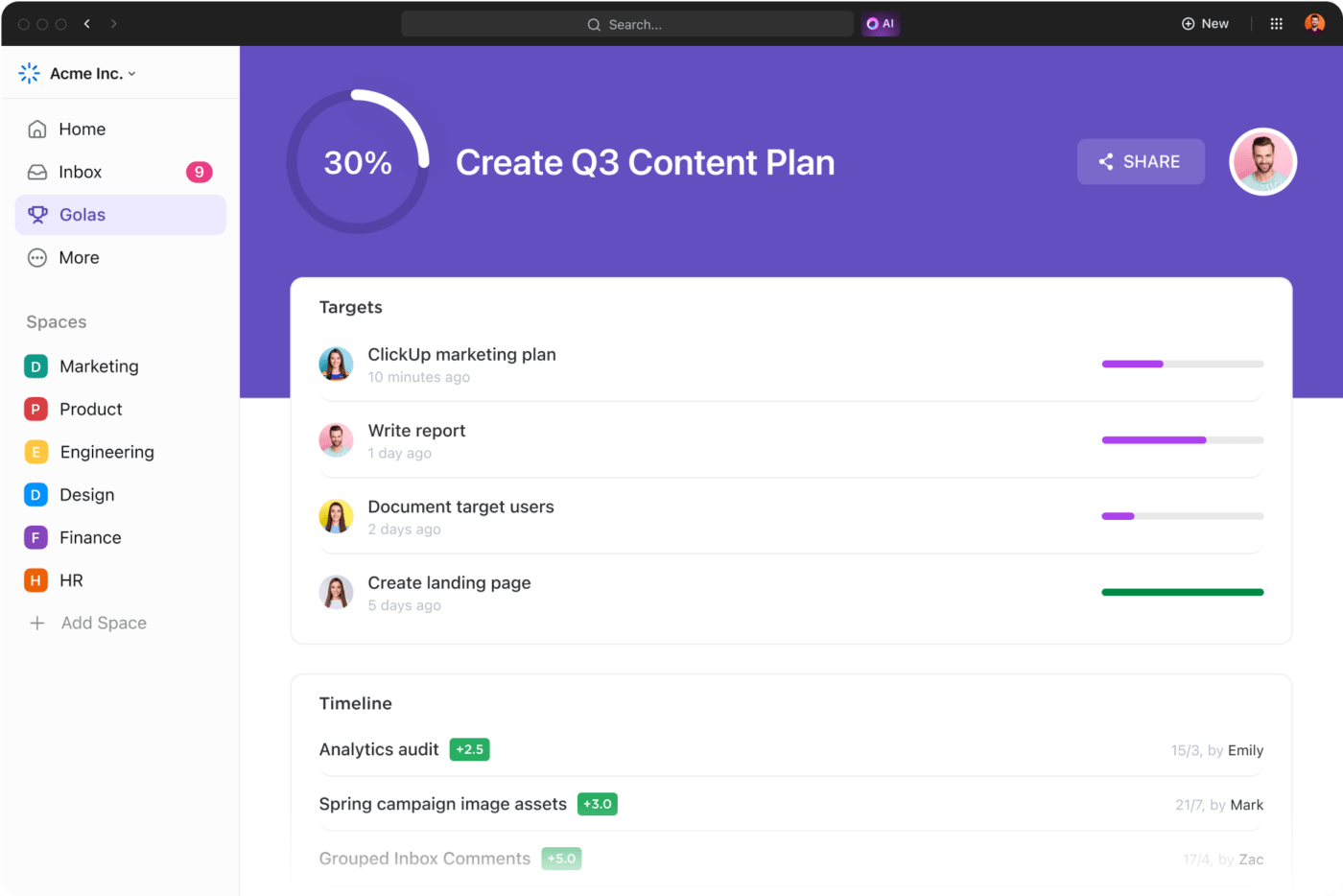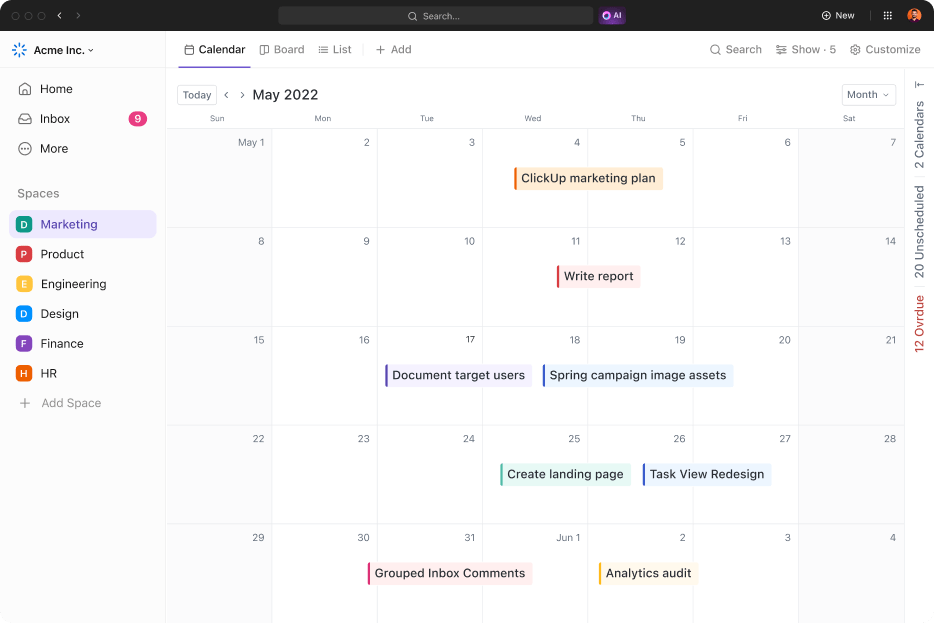ليس سراً أن تحديد الأهداف مرتبط بالنجاح. وجدت شركة INC أن الأشخاص أكثر عرضة بنسبة 42% لتحقيق الأهداف التي يكتبونها. بالإضافة إلى ذلك، فإن الموظفين الذين لديهم أهداف واضحة 3.6 مرات أكثر احتمالاً أن يكونوا مخلصين لشركتهم.
لكن الحقيقة هي أن العديد من الشركات لا تضع أولويات واضحة. وجدت إحدى دراسات هارفارد بيزنس ريفيو أن 84% من الموظفين الذين شملهم الاستطلاع في إحدى شركات الخدمات المهنية لم يكونوا على دراية بالأولويات العليا للمؤسسة. بالإضافة إلى ذلك، لم يتمكن سوى 55% من المديرين من تحديد أحد أهم خمسة أهداف للشركة.
فلماذا تواجه العديد من الشركات مشاكل في تحديد الأهداف؟ يمكن أن تكون العملية صعبة، وهي أكثر من مجرد وضع بيان أهداف شامل. يجب أن تكون الأهداف الفعالة قابلة للقياس وموجهة نحو أهداف الشركة.
وهنا يمكن أن تساعد الأهداف المتتالية. 👀
سنتحدث هنا عن ماهية الأهداف المتتالية ونحدد فوائد استخدامها في شركتك. بعد ذلك، سنوضح لك كيفية تنفيذ الأهداف المتتالية لمساعدة جميع أعضاء الفريق على المساهمة في تحقيق أهدافك.
ما هي الأهداف المتتالية؟
الأهداف المتتالية هي إطار عمل منظم للأهداف. ابدأ بأهداف تنظيمية أكبر وقم بتقسيمها إلى أهداف أصغر للفرق والأفراد. الفكرة هي أن يعمل الجميع على تحقيق الهدف الرئيسي للشركة من خلال العمل على المهام والمشاريع التي تساهم في تحقيقه.
تبدأ العملية بإنشاء أصحاب المصلحة هدفاً شاملاً للشركة. بعد ذلك، يتم تحديد الأهداف والمهام لمديري المشاريع وقادة الفرق لتحقيق هذا الهدف الرئيسي. وتستمر العملية بتأثير متسلسل لكل عضو في الفريق وكل فرد في الشركة. ✨
ينصب التركيز على البدء بالهدف الرئيسي والعمل بشكل عكسي لإنشاء المشاريع والمهام لكل فريق والتي تقرب الشركة من الهدف. يجب أن يكون كل هدف متتالي واضحًا وقابلًا للقياس. كما يجب أن تكون مصممة حسب قدرات وإمكانيات كل عضو من أعضاء الفريق.
## أنواع الأهداف المتتالية
ضمن هذا الإطار الأوسع للأهداف توجد عدة أنواع من الأهداف المتتالية. يقدم كل منها نهجًا أو أسلوبًا مختلفًا للوصول إلى الهدف الرئيسي. 🏆
تتضمن أنواع الأهداف المتتالية ما يلي:
- أهداف SMART: أهداف SMART محددة، وقابلة للقياس، وقابلة للتحقيق، وذات صلة، ومحددة زمنيًا. صُممت هذه الأهداف لتكون واقعية وقابلة للتنفيذ
- الأهداف و النتائج الرئيسية ( OKRs): تأخذ الأهداف الرئيسية هدفًا شاملاً وتربطها بنتائج ومهام رئيسية مصممة كخطوات لتحقيق الهدف الرئيسي
- الأهداف الجريئة الكبيرة (BHAG): هدف طويل الأجل يهدف إلى إثارة الحماس من خلال وضع معيار عالٍ للنجاح الذي غالبًا ما يكون جريئًا ومحفوفًا بالمخاطر وشامخًا

استخدم قالب أهداف ClickUp الأهداف الذكية قالب لهيكلة وتبسيط استراتيجيات تحديد الأهداف في نظام يمكن التحكم فيه
## أمثلة على الأهداف المتتالية
لنأخذ وكالة سفريات كمثال على الأهداف الذكية المتتالية. قد يكون هدف الشركة الرئيسي لربع السنة هو بيع 5,400 باقة عطلات. يجب توجيه كل مهمة وهدف لكل فريق نحو تحقيق ذلك. قد يعني ذلك أن فريق المبيعات قد يضع هدفًا يتمثل في تأهيل 1,300 عميل جديد. وقد يهدف فريق التسويق إلى إرسال 40 حملة تسويقية عبر البريد الإلكتروني.
وضمن فريق المبيعات، قد يحدد مدير المبيعات أهداف التحويل لكل مندوب مبيعات - مثل 150 عميلاً جديداً لكل فرد. على جانب التسويق، قد يقوم المدير بتقسيم العمل إلى أهداف تستند إلى زيادة تحويلات وسائل التواصل الاجتماعي أو إنشاء عدد معين من الحملات الإعلانية.

ClickUp لوحة معلومات OKR يصمم طرق عرض مخصصة للمشاريع متعددة الوظائف، ويعزز الكفاءة من خلال الأتمتة، ويوحد أفضل الممارسات لتحقيق نجاح قابل للتطوير
دعنا الآن نلقي نظرة عن كثب على مثال على الأهداف المتتالية باستخدام OKRs. لنفترض أن مالك وكالة لبيع القوارب يضع هدفًا رئيسيًا ليصبح أكبر بائع للقوارب في المنطقة.
قد تبدو النتائج الرئيسية لهذا الهدف كما يلي:
- النتيجة الرئيسية #1: التعامل مع 55% من جميع مبيعات القوارب الإقليمية
- النتيجة الرئيسية #2: تعزيز العلامة التجارية والظهور بنسبة 35%
- النتيجة الرئيسية #3: تنفيذ نظام إدارة علاقات العملاء للتعامل مع جميع مشاركات العملاء
كما ترى، تؤثر هذه النتائج الرئيسية على مختلف الأقسام، بما في ذلك المبيعات والتسويق. من هنا مدراء الفرق أن يتخذوا إحدى هذه النتائج الرئيسية كهدف رئيسي للفريق. ثم يقومون بتقسيمها إلى نتائج رئيسية أخرى لتحقيق هذا الهدف.
على سبيل المثال، قد يكون لدى فريق المبيعات 55% من جميع مبيعات القوارب الإقليمية كهدف رئيسي ويمكن أن تشمل النتائج الرئيسية توظيف ثلاثة مندوبي مبيعات جدد وزيادة عدد مبيعات القوارب بنسبة 40% على أساس سنوي. ويمكن أن تشمل النتائج الرئيسية لفريق التسويق تعيين استشاري لبناء نظام إدارة علاقات العملاء وتشغيل 10 حملات إعلانية أو مبادرات تسويق عبر البريد الإلكتروني.
فوائد تحديد الأهداف المتتالية
فوائد تحديد النهج التنازلي لتحديد الأهداف يشمل المزيد من الموظفين المخلصين، والعمل المستهدف، وتحسين التعاون. بدءًا من المستوى التنفيذي نزولاً إلى الموظفين المبتدئين، يرتبط الجميع بهدف واحد ويتم تحديد نطاق عملهم لتلبية الأهداف الرئيسية والأهداف الشخصية للموظف.
فيما يلي بعض الفوائد الرئيسية لوضع الأهداف المتتالية. 💪
أفضل إدارة الأداء
الأهداف المتتالية تجعل مراقبة الأداء وتقييمه في جميع أنحاء المؤسسة بأكملها أسهل. مع تصميم أهداف المشروع لكل عضو من أعضاء الفريق، فمن السهل قياس أداء كل موظف.
نظرًا لأن الأهداف المتتالية عادةً ما تكون قابلة للقياس، يمكنك استخدام المقاييس لمعرفة مدى اقتراب الفريق أو الشخص من تحقيق هدفه، أو أين تأخرت المشاريع، أو تسليط الضوء على شيء ما نجح بشكل جيد.
زيادة مشاركة الموظفين
يعمل الموظفون بشكل أفضل عندما يكون لديهم أهداف تساهم بشكل مباشر في نجاح المؤسسة. وهذا يعني أنهم سيكونون أكثر استعدادًا لتولي مشاريع جديدة، وتوليد أفكار إبداعية، والتركيز على العمل المهم. سيتم تحفيزهم على أتمتة الأعمال المشغولة وتخصيص وقتهم لمهام أكثر أهمية.

عرض الأتمتة النشطة وغير النشطة وإدارتها بسرعة عبر المساحات مع تحديثات المستخدم وأوصافها
تحسين الاستراتيجية و مواءمة الأهداف
تعاني العديد من الشركات من مشاكل في المواءمة - خاصةً عندما يشارك أكثر من قسم في نفس المشروع. إن تحديد أهداف الشركة الكبيرة وتقسيم العمل لكل قسم لتحقيق تلك الأهداف يجعل من السهل الحفاظ على المواءمة والتبسيط إدارة العمليات التجارية . 📈
عندما تقرر توسيع نطاق الشركة أو مشروع ما، من السهل عزل الموظفين الجدد. فقط فكر في هدف الشركة الرئيسي وما يمكن أن يساهم به الشخص الجديد للوصول بالفريق إلى خط النهاية.
تبسيط سير العمل والمهام المستهدفة
مع تعاقب الأهداف، يسهل على المديرين إنشاء مهام سير العمل وتعيين المهام على مستوى الشركة والمستوى الفردي. مع وضع الهدف العام في الاعتبار، قم بتقسيم المهام إلى خطوات يمكن التحكم فيها على كل مستوى من مستويات المؤسسة. ✍️

قم بتعزيز الوضوح عبر مشاريعك باستخدام أنواع المهام القابلة للتخصيص وتحسين التنظيم عبر جهود إدارة المهام الخاصة بك
يمكنك أيضًا إنشاء الأولويات والتبعيات لتوجيه العمل، سواء كانت أهدافًا جماعية أو فردية. قم بتمييز المهام ذات التأثير الأكبر والجهد الأقل ليتم التعامل معها أولاً. بعد ذلك، حدد المجالات التي تتطلب مهمة أخرى قبل بدء العمل. باستخدام الأهداف المتتالية كدليل إرشادي، يمكنك إنشاء قوائم مهام يومية لإدارة تتبع المشروع نحو النجاح
تزيل هذه الأهداف أيضًا التكرار، خاصة بالنسبة للفرق الكبيرة. بالإضافة إلى أنها تتجنب الأهداف المتنافسة وتحافظ على تركيز الجميع على العمل.
المزيد من الشفافية والمساءلة
مع عمل الجميع على تحقيق أهداف الشركة، تضيف الأهداف المتتالية عنصر المساءلة. فكل شخص يعرف ما هو العمل المسؤول عنه وما هي المساهمة المتوقع أن يقدمها. وهذا يزيد من الشفافية ويتيح للموظفين تولي مسؤولية المشاريع خلال عملية تحديد الأهداف.
## كيفية التنفيذ الأهداف المتتالية
تنفيذ الأهداف المتتالية مستمر وينبغي إعادة النظر فيها على مدار العام. من الجيد أيضًا الحصول على موافقة الموظفين والسماح لهم بإبداء رأيهم في أهدافهم الفردية والجماعية. وبهذه الطريقة، سيشعرون بأنهم أكثر ارتباطًا بالعمل وسيكون لديهم ملكية أكبر للمشروع. إليك كيفية تنفيذ الأهداف المتتالية في عملية بسيطة من خمس خطوات. ✅
1. مراجعة مهمة الشركة وتحديد الأهداف طويلة المدى
قبل أن تفكر في تحديد الأهداف، من المهم أن تفكر في مهمة الشركة - والتي قد تكون غير واضحة بالنسبة للموظفين في الشركات الكبرى. يجب أن توجه رسالتك وقيمك عملك دائمًا. إنها الدافع وراء هدفك وسبب قيامك بالعمل.
من خلال فهم رسالة شركتك وقيمها، يمكنك وضع أهداف قابلة للتحقيق تدفع عملك إلى الأمام. كما أن ضمان فهم الموظفين للرسالة يجعلهم أفضل في وظائفهم وأكثر انسجامًا مع احتياجات الشركة. 🧐

وضع أهداف قابلة للقياس للمهام والمشروعات مع التقدم التلقائي لتحقيق الأهداف بفعالية أكبر مع جداول زمنية محددة وأهداف قابلة للقياس الكمي
بمجرد معرفة مهمتك، استخدم أداة مثل انقر فوق الأهداف لتحديد أهداف قابلة للقياس. يجعل برنامج تحديد الأهداف هذا تحديد الأهداف وتعيينها وإدارتها ومراقبتها أمراً سهلاً. استخدمه لتحديد وتتبع التقدم المحرز باستخدام SMART Goals ومؤشرات الأداء الرئيسية و OKRs.
ابدأ بإنشاء هدف رئيسي للشركة وجميع الأقسام أو الفرق. ثم انتقل إلى كل فريق وفرد لإنشاء أهداف قابلة للتحقيق تساهم في تحقيق الأهداف الرئيسية على مستوى الشركة. قم بإعداد اجتماعات مع كل عضو من أعضاء الفريق لإعطائهم مدخلات في أهداف محددة والعمل الذي يعتقدون أن له أكبر الأثر.
نظّم أهداف العمل في مجلدات للاطلاع على الأهداف الرئيسية لكل عضو في الفريق أو الأهداف الفردية. تضيف ميزة تعقب التقدم مخطط النسبة المئوية لإظهار عدد المهام التي تم إنجازها نحو تحقيق الهدف.
2. وضع أهداف قصيرة الأجل أهداف على أساس ربع سنوي
الأهداف المتتالية الفعالة هي مزيج من الأهداف قصيرة الأجل وطويلة الأجل . بمجرد تحديد الأهداف السنوية الرئيسية لكل فرد، قم بتقسيمها إلى أهداف ربع سنوية. 🛠️
استخدم أداة مثل قوالب تحديد الأهداف في ClickUp لجعل هذه المهمة أسرع وأسهل. مع وجود العديد من الخيارات للاختيار من بينها، يمكنك تحديد أهداف SMART أو OKRs أو بطاقات الأداء المتوازن أو الأهداف المهنية في نصف الوقت.

يوفر قالب OKR الخاص ب ClickUp للفريق التنفيذي مصدرًا واحدًا للحقيقة لتتبع التقدم المحرز في الوقت الفعلي
يمكنك التخطيط للأهداف للسنة بأكملها مقسمة إلى أرباع ولكن يمكنك إعادة النظر فيها كثيرًا. من الناحية المثالية، يجب أن تجتمع في نهاية الربع لمراجعة العمل المنجز وتحديد الأهداف للربع التالي للبقاء على المسار الصحيح لتحقيق أهداف الشركة الأكبر.
ميّز بين الأهداف والغايات -الأهداف هي الغايات الرئيسية، بينما تساعد الغايات الموظفين على فهم كيفية تحقيق هذا الهدف. ويلعب كل منهما دورًا رئيسيًا في تحديد أولويات العمل الصحيح كل ثلاثة أشهر.
3. وضع أهداف فردية و أهداف الفريق
كرر عملية تحديد الأهداف هذه لكل عضو من أعضاء الفريق والفريق. تأكد من أن يكون لهم رأي في عملية اتخاذ القرار عند اختيار الأهداف والغايات. تذكر أن جميع المشاريع والمهام يجب أن ترتبط بالهدف الرئيسي للشركة والأهداف الفصلية.
استخدم أولويات النقر فوق الأولويات لإنشاء مهام سير العمل التي تقسم العمل بناءً على الأهمية. أضف حقولاً مخصصة للعمل الأكثر تأثيراً والأقل جهداً. استخدم الترميز بالألوان لتحديد المهام التي يسهل إكمالها والمهام التي سيكون لها التأثير الأكبر بسهولة.

تعيين أولوية المهمة بسرعة داخل المهمة لتوصيل ما يحتاج إلى الاهتمام أولاً انقر فوق التبعيات أيضًا تسهيل تحديد العمل الذي يتم حظره بواسطة مهمة أخرى. بهذه الطريقة فرق متعددة الوظائف أن ترى بسرعة العمل الذي تحتاج إلى القيام به لمنع التأخير في سير العمل لبقية الشركة.
4. التحقق من الأهداف المتقاطعة التي تعمل من من الأسفل إلى الأعلى
بمجرد تحديد الأهداف لكل فرد وفريق العمل والشركة، ستحتاج إلى التحقق من توافق كل شيء مع خطتك الاستراتيجية. اعمل من الأسفل إلى الأعلى-مراجعة جميع الأهداف الشخصية وفريق العمل و أهداف إدارة المشروع إلى أعلى المستويات في الشركة
لاحظ الأهداف التي لا تتماشى مع استراتيجية عملك أو المجالات التي تحتاج إلى تحسين. قم بعرض خطة الأهداف على الإدارة وأصحاب المصلحة الرئيسيين لضمان المراجعة المناسبة.
5. ضع جدولاً زمنيًا للمراجعة و مراجعات الأداء
كما هو الحال مع معظم المشاريع، لا يمكنك تنفيذها ونسيانها. المراجعات هي المفتاح للبقاء على رأس الأهداف الاستراتيجية والتكيف حسب الحاجة. استخدم عرض التقويم الخاص بـ ClickUp لتتبع التقدم المحرز وجدولة عمليات التحقق المنتظمة. 💼

إدارة المشروعات وجدولة المهام عبر طريقة عرض التقويم المرنة للحفاظ على مزامنة الفرق
لا تُعد عمليات تسجيل الوصول مجرد وقت لمراجعة أهداف الأداء، بل هي فرصة رائعة للحصول على التعليقات وتحسين الاحتفاظ بالموظفين. خطّط لتخصيص نصف ساعة أو ساعة لمراجعة الأهداف الفردية والحصول على رؤى على أرض الواقع.
أثناء الاجتماعات، راجع الأهداف العامة للشركة, أهداف القيادة والتقدم الشخصي. قرر ما إذا كنت بحاجة إلى تحديد أهداف جديدة لتحقيق أهداف أعلى أو تعديلها لتناسب تغيرات السوق. ضبط الأهداف والجداول الزمنية بناءً على ملاحظات الموظفين وتقديم الدعم عند الحاجة.
حدد الأهداف وحققها بشكل أسرع مع ClickUp
سواء أكنت تضع أهدافك الخاصة للوصول إلى أحلامك أو إدارة فريق العمل نحو مهمة أكبر للشركة، يمكن أن تساعدك الأهداف المتتالية على تحديد الأولويات وتحقيق أهدافك. باستخدام الدليل المكون من خمس خطوات أعلاه، ستتمكن من وضع أهداف قابلة للتحقيق والقياس لكل مرحلة من مراحل العملية. اشترك في ClickUp اليوم وابدأ في بناء فرق عمل أكثر فعالية واندفاعًا. مع ميزة الأهداف، أصبح إنشاء أهداف للشركة ولكل موظف أمراً سهلاً. بالإضافة إلى ذلك، فإن مهام سير العمل المضمنة وإدارة المهام وإعداد التقارير تبقيك على اطلاع على التقدم المحرز حتى تتمكن من تحقيق أهدافك بشكل أسرع.

